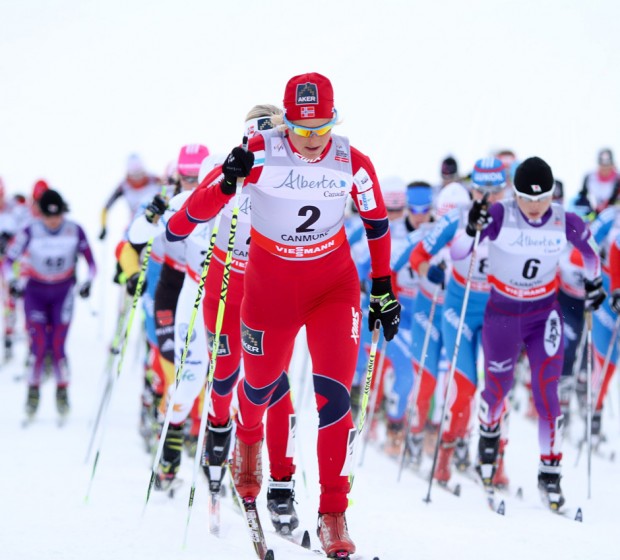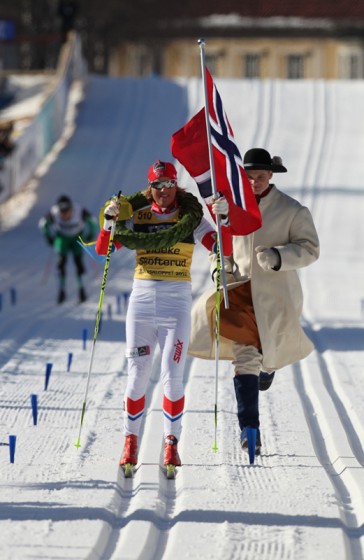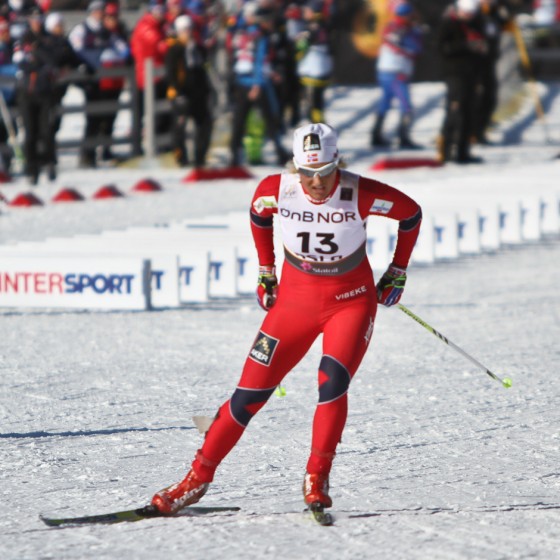
Norwegian ski star Vibeke Skofterud has been opening up about her past eating disorders in the last few weeks, hoping to make a positive impact on young women and athletes.
“To be a top athlete is seldom a bed of roses,” the former national team member wrote on her blog, according to a translation. “I’ve written before that achieving success is all about taking the right choices in life. What affects those choices can be so many things. I broke through in 2001, and got headlines like ‘nordic world has a new pop star,’ fearless Vibeke, new stars, etc. … It went pretty well until I failed to fulfill either my own or others’ expectations, and I began to lose weight. I am a person that is triggered by the extremes, and unfortunately that is also true in terms of losing weight.”
Skofterud has had success at all levels of skiing, with 14 individual World Cup podiums, a relay gold medal from the 2010 Olympics in Vancouver, and four World Championships relay medals with Norway. She has also won major marathons and is a sports personality in her home country. She has been open about her eating disorder in the past, including that it caused her to end the 2008 season early.
After retiring from the national team, she has been focusing on marathon racing, which is just as lucrative and in-the-spotlight as World Cup racing in Scandinavia. Although she sat out the 2014/2015 season to heal injuries, Skofterud is in the spotlight not only because of her skiing exploits but because of mainstream exposure (if the two can even be separated in Norway): she made the semifinals of the reality television show “71 Degrees North: Norway’s Toughest Celebrity.”

She wrote on her blog in late April that during a particularly low period in her life, her weight could vary by as much as 10 kilograms (20 pounds) during the course of a month.
“That in itself is not consistent with performance over time,” she wrote. “… I ate too little over time, and I ate too much, I threw up … Everything came down to personality, because I could not totally see who I was.”
When pressure was particularly high, Skofterud explained, she lost weight. But later, she gained some.
“Food was dope,” she wrote. “Food became a substitute for the self-care I could not give myself. I maybe didn’t quite see my value as a human being.”
What Are The Stakes?
There are many ways to measure the magnitude of the disordered eating problem in athletics, but here are a few metrics:
- An oft-cited 2004 article in the Clinical Journal of Sports Medicine found that 13.5 percent of athletes surveyed, compared to just 4.5 percent of the normal population, had clinically-defined eating disorders or borderline behavior. The study was carried out in Norway and used more than 1600 athletes and almost 1700 “control” subjects.
- The largest study of NCAA athletes, which surveyed over 1,400 men and women, found that female athletes were significantly more likely to engage in binge eating, vomiting and the use of laxatives than male athletes. They were also more likely to use diet pills. This study found that 34.75 percent of women compared to 9.5 percent of men were at risk for anorexia, while 38 percent of athletes overall were at risk for bulimia.
- A 2013 study, though it had a small sample size, found that only 9 percent of female NCAA athletes surveyed were consuming enough calories to sustain their training load. A study of over 400 female Division-I swimmers and gymnasts found that 30 percent self-reported some form of disturbed eating habits.
- For high school athletes, studies have found a range of prevalences for eating disorders, depending to some extent upon the type of sport. Estimates have ranged from 15 percent to more than 30 percent of female high school athletes engaging in some form of disordered eating.

While disordered eating is more prevalent among female than male athletes, it’s also in some ways more dangerous for women. Having low available energy can lead osteoporosis. Bones are perpetually remodeling, with some bone being reabsorbed and new bone forming; low available energy can mean that while some bone is reabsorbed, not enough forms to replace it. This is a long-term health problem, but also a short-term one for athletic performance, as bone loss can lead to stress fractures.
A three-year study of elite high school distance runners found that although the young women learned some important concepts of sports nutrition over their careers, they reduced their caloric intake over the study period. At the same time, the incidence of stress fractures increased from 13 percent to 31 percent.
Thus, eating disorders are part of what is referred to as the “female athlete triad:” disordered eating, bone loss and skipping periods (amenorrhea), which in itself can lead to long-term problems and even infertility. In a survey of 788 Iranian women athletes, about 10 percent who skipped periods had polycystic ovary disorders, which can lead to not only infertility but mood disorders and heart disease.
But there are other connected side effects, too, such as gastrointestinal problems, reduced immune system functioning, and hypothyroidism. And even without a clinically-diagnosed eating disorder, behavior tending in that direction can still lead to the complications of bone loss, menstrual irregularity, and other problems, a 2002 study reported.
Why So Many Eating Disorders?
There are a lot of different reasons that an individual might develop an eating disorder. In sports, where it’s undeniable that certain body types are more ideal for high performance in a particular discipline than are others, there’s particular pressure. The National Eating Disorders Association writes on its website that athletes are particularly at risk if they work with “coaches who focus primarily on success and performance rather than on the athlete as a whole person.”

But a 2011 study in the European Eating Disorders Review found that in elite female athletes, eating disorders were almost inextricably tied to issues of body image. Even if they had the same actual weight, female athletes who developed eating disorders perceived themselves to be fatter than other athletes.
This has two components. One is the fact that in endurance sports which emphasize leanness, athletes are pressured to be thin and commonly believe that being thinner will help their performance. Thus, some disordered eating by athletes is related to sport-specific body image. A recent study found that 62 percent of Australian female cyclists competing at national and continental championships thought that their body weight was not ideal for competition.
This was certainly the case for Skofterud. On her blog she posted an excerpt from her diary in 2011, before a World Cup in Davos, Switzerland.
“Every day I avoid the mirror so I don’t see myself,” she wrote. “I cannot bear to remind myself how weak I was … it is crazy. I get fatter and fatter, and life as a top athlete is almost distant. In two days I will go the World Cup. Compete against the world’s best … I’ll try not to think about that ski suit does not fit properly.”
In the 10 k classic race, Skofterud finished second, 10.9 seconds behind Virpi Kuitunen of Finland. Clearly, she was in fact among the world’s best.
Later in her career, she has become more cognizant of her own problems with eating. In 2012, she focused not only on the World Cup but also on the Vasaloppet, a 90-kilometer classic race in Sweden. She succeeded in becoming the first Norwegian woman ever to win the race, and lowered the record time by over eight minutes on the way. She also finished sixth in the World Cup distance standings that season.
It was partly because of better diet that this was possible.
“Some have [an eating] plan, while others eat by emotion, desire and needs,” she wrote in a May blog post. “I have previously told about my turbulent relationship with food, but this season was better mostly. I hit my match weight thanks to close monitoring of by the Olympic trainers and grueling discipline of myself.”
But body image is not only related to sport, it is also related to social norms. Even if a woman is satisfied with her body as it relates to athletic performance, once placed in a social setting she may have negative self-image. Thus social body image can also drive disordered eating.
And Skofterud wrote about this, too.
“My focus was no longer on performance, but to try to look nice enough to walk around in ski suits,” she wrote.
“I also worked continuously to get a better ass, a flatter stomach, better stamina, nice skin, be funnier, smarter, and more productive,” she wrote in a more recent post.
Speaking Up
“At the time when I developed my eating disorder, it was a very ‘shushed’ theme,” Skofterud wrote. “No talking loudly about it…”
She thinks this should change, and is also increasingly worried about the portrayals of dieting in pop culture – that eating is “no longer focused on health, but focused on looking good.” Skofterud cited Norway’s version of the television show “The Biggest Loser” as one which creates unhealthy perceptions of how to be healthy.

“I have great respect for the participants and program leaders,” she wrote. “For me, Adrian and Tonje are two great role models in all possible ways. But to create entertainment where overweight people will compete to go as fast as possible, to lose weight in the shortest possible time – it will be too much for me when I know what the repercussions might be.”
Chasing aesthetics takes away from the important things in life, and Skofterud recently wrote about how important it is to take time to think about all the positive things one has accomplished. Whether it was dieting or training more than 1,000 hours a year for skiing, she felt that for long periods of time, she didn’t do that. She hopes others will and seeks to be an inspiration.
“What doesn’t need be the case is how we treat ourselves badly,” she wrote. “I completely forgot to appreciate what I did and what I accomplished, to give myself a pat on the back. To be proud of my achievements … Do not forget why you’re doing what you’re doing. Do not forget what makes you happy. What is it that really makes you happy?”
Chelsea Little
Chelsea Little is FasterSkier's Editor-At-Large. A former racer at Ford Sayre, Dartmouth College and the Craftsbury Green Racing Project, she is a PhD candidate in aquatic ecology in the @Altermatt_lab at Eawag, the Swiss Federal Institute of Aquatic Science and Technology in Zurich, Switzerland. You can follow her on twitter @ChelskiLittle.



